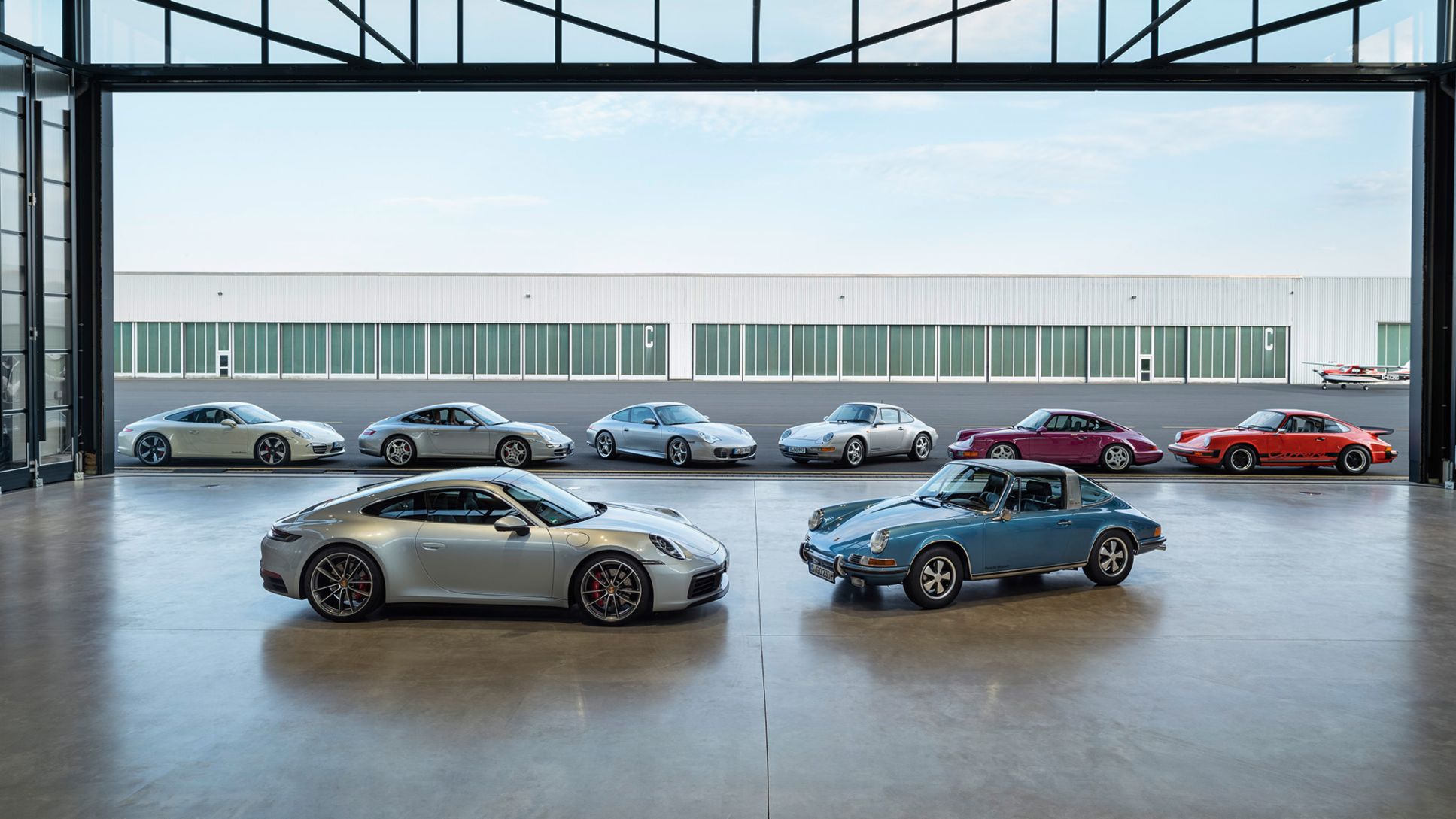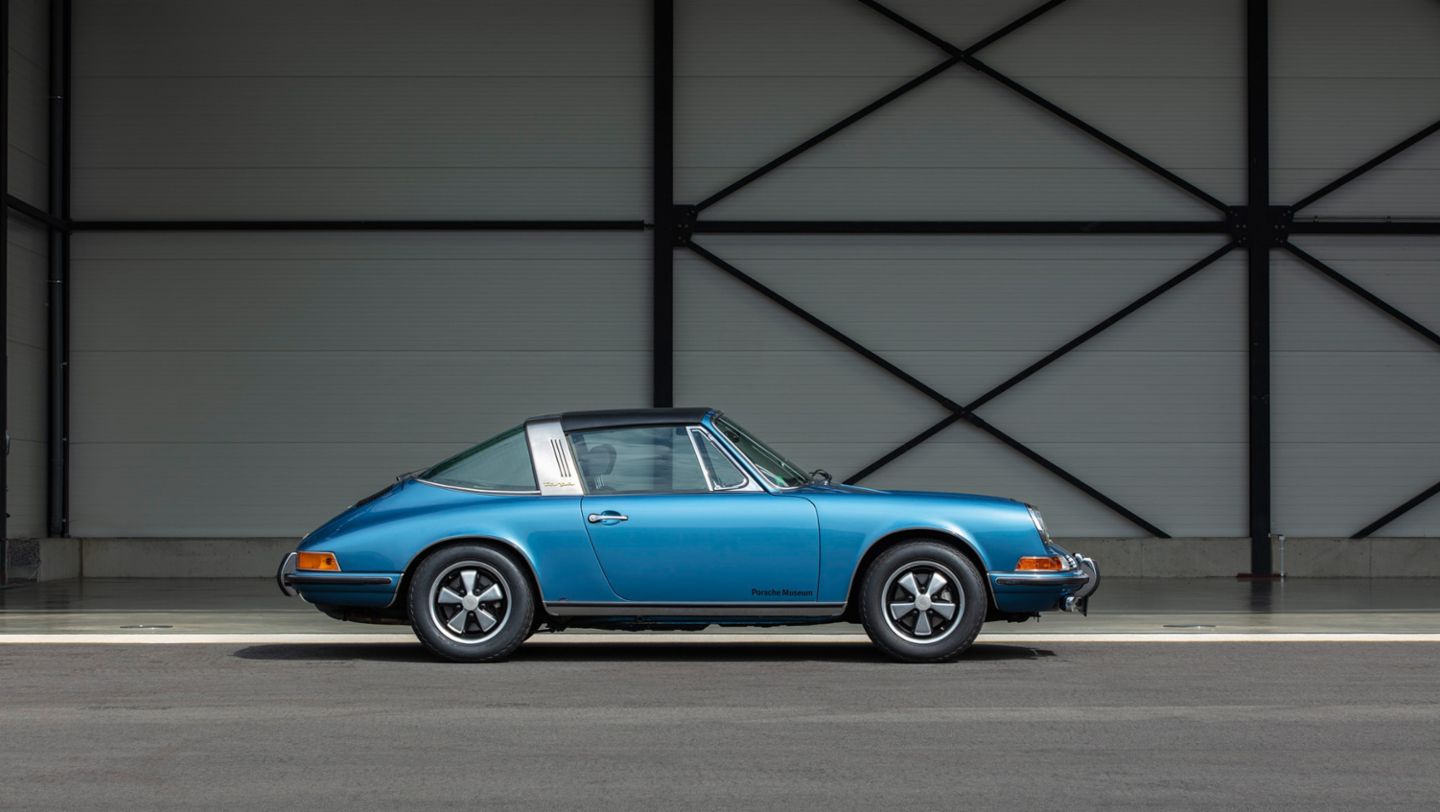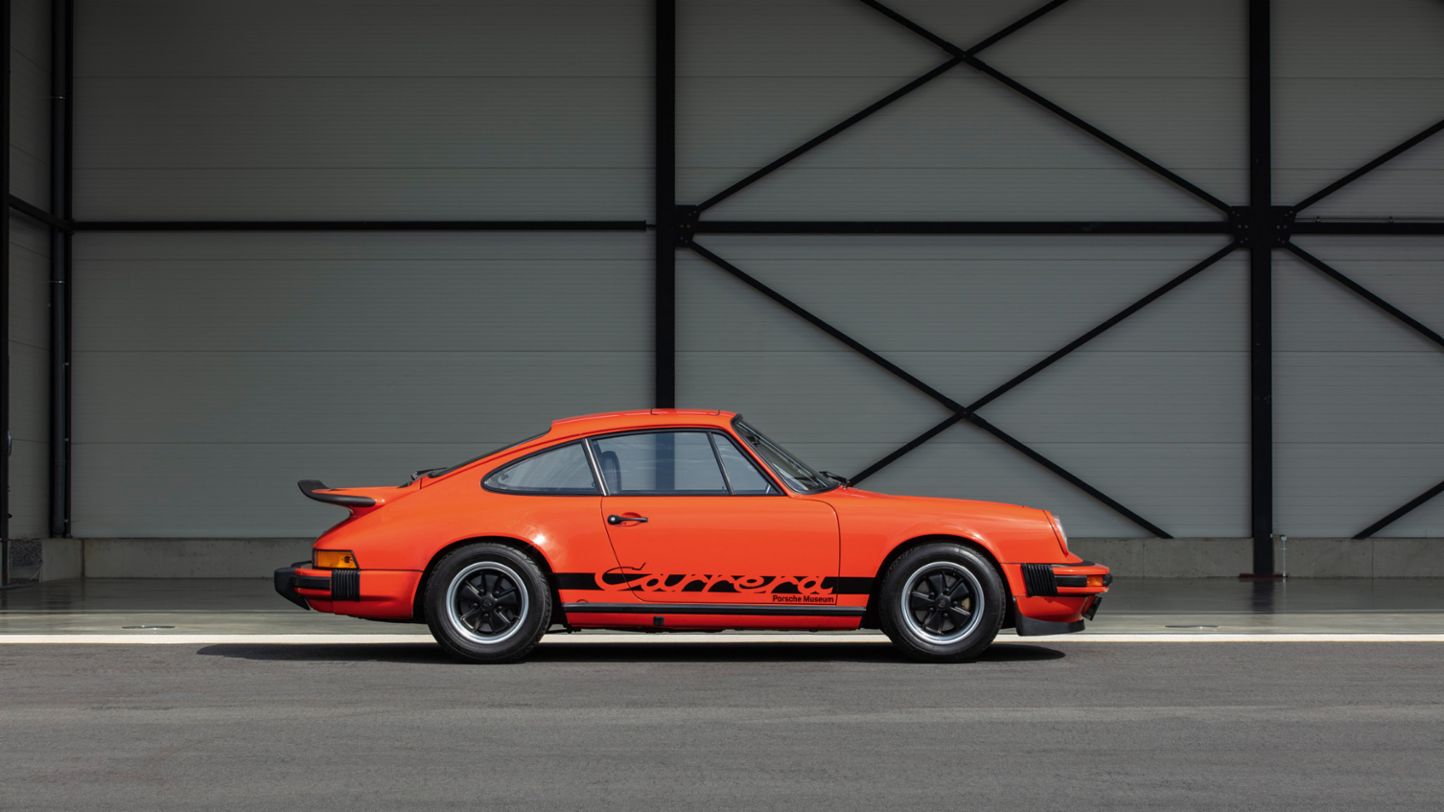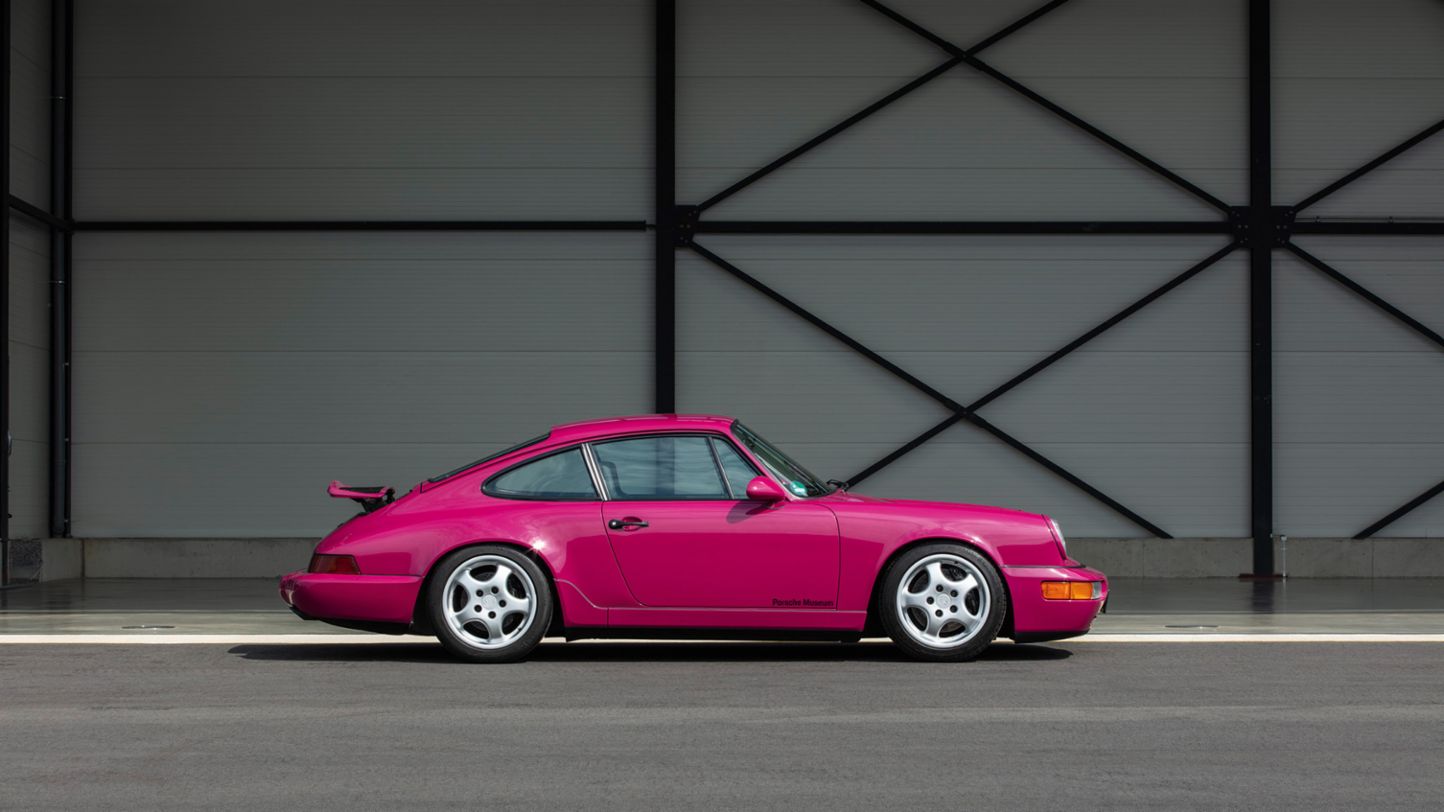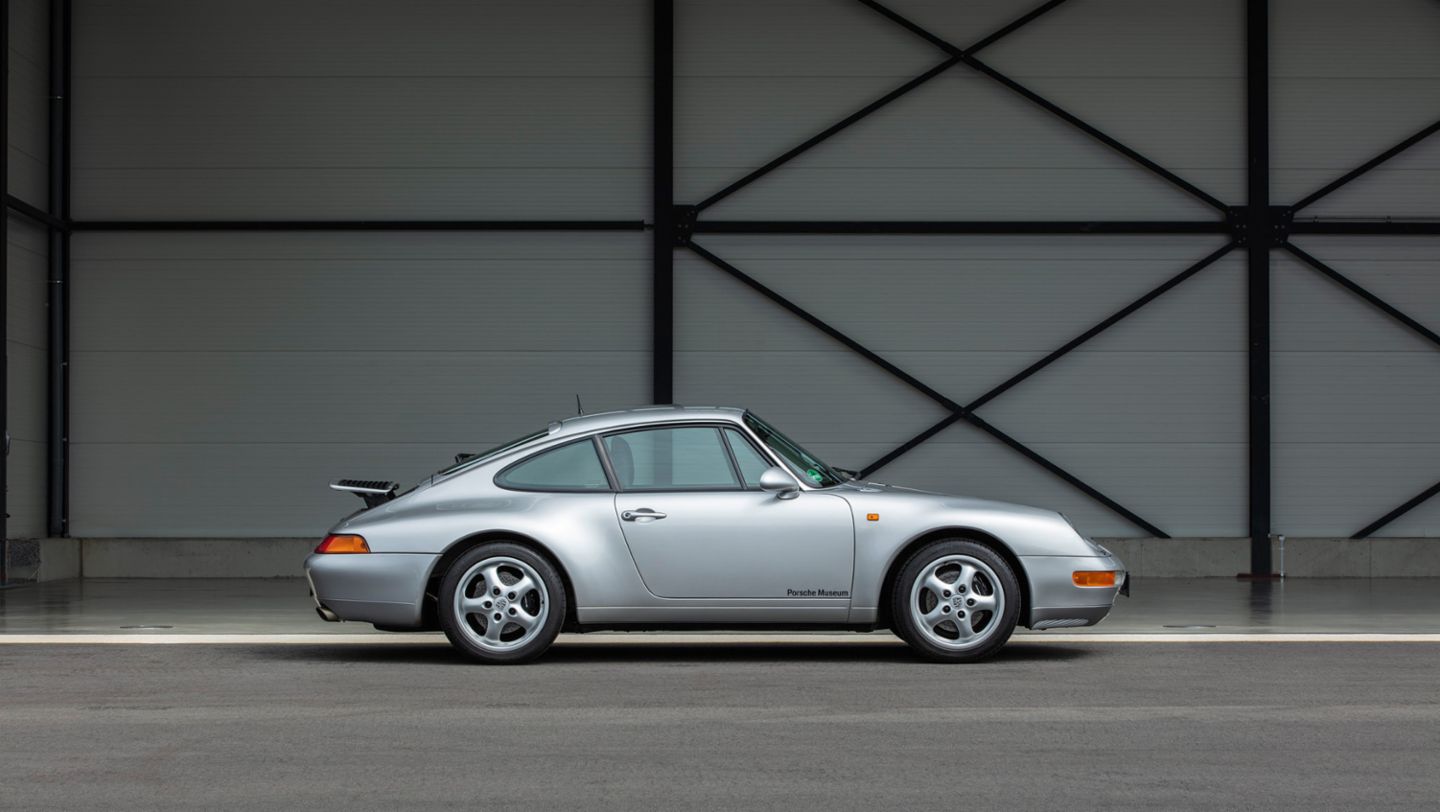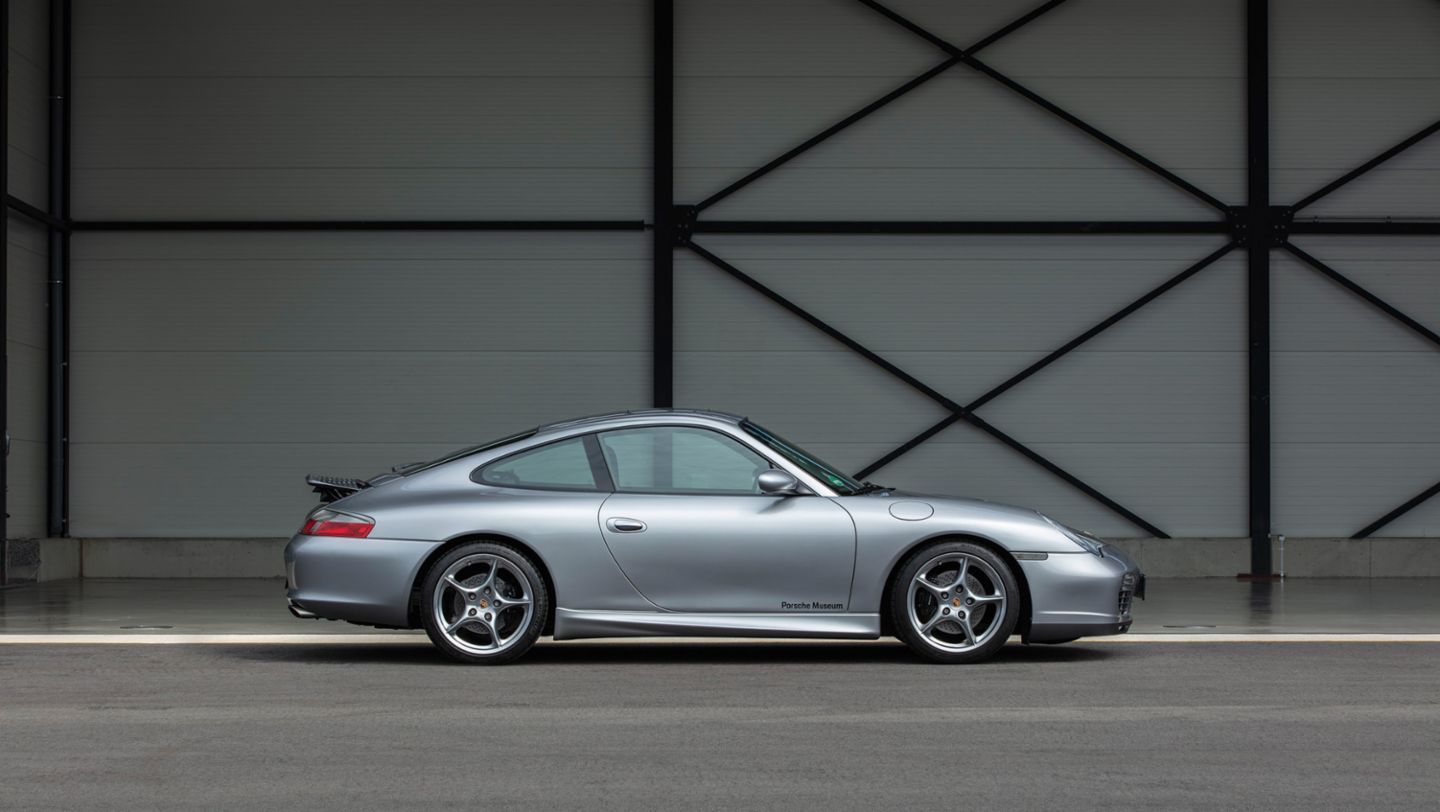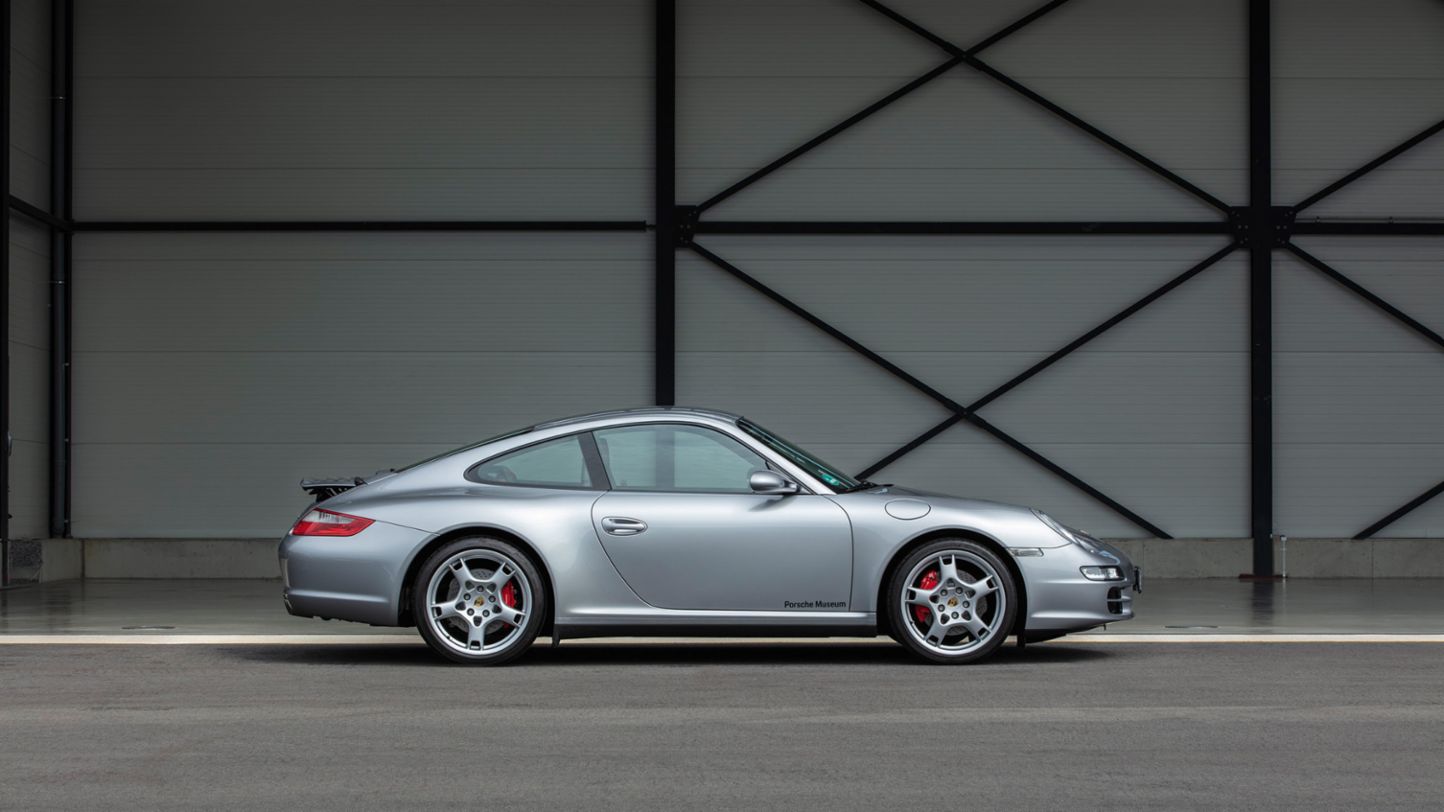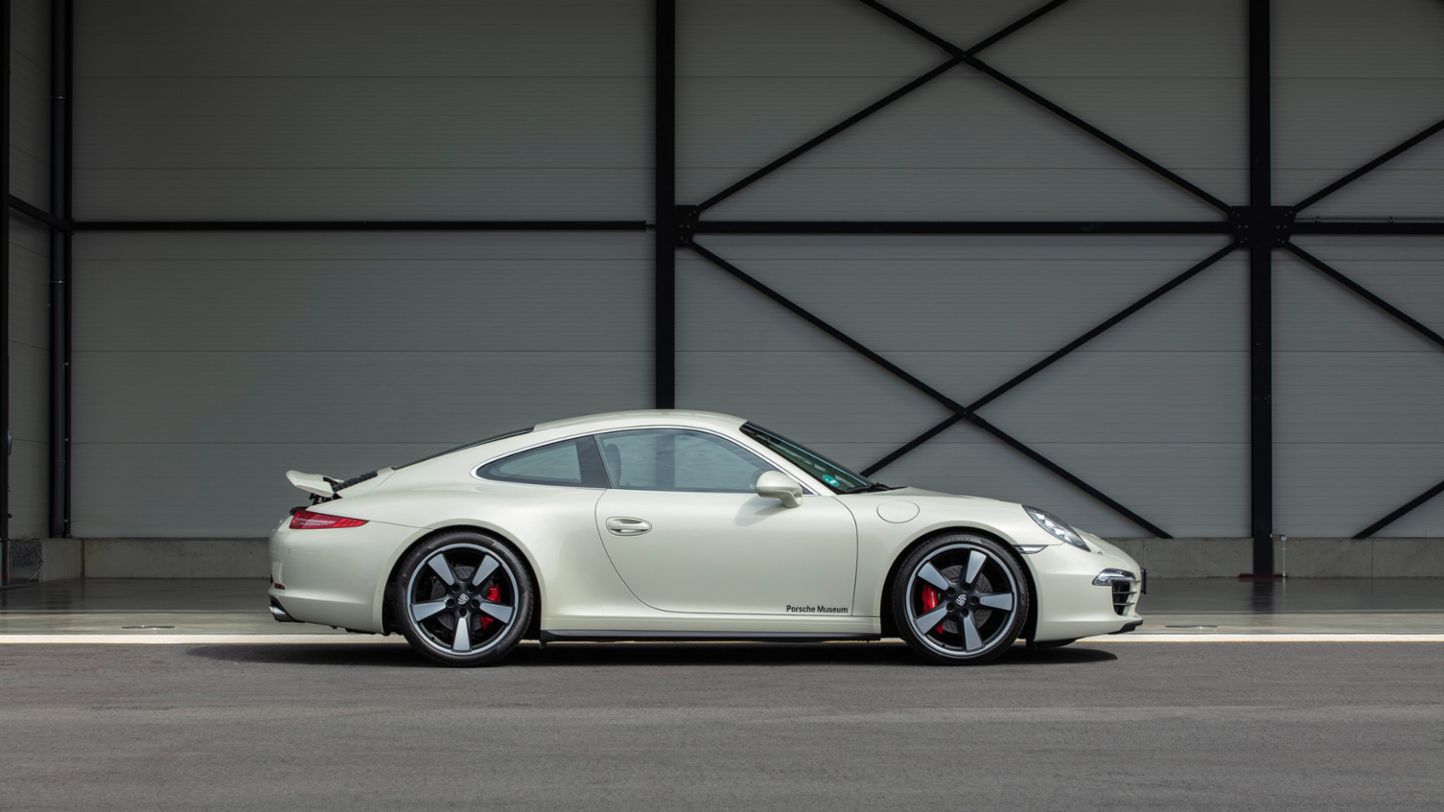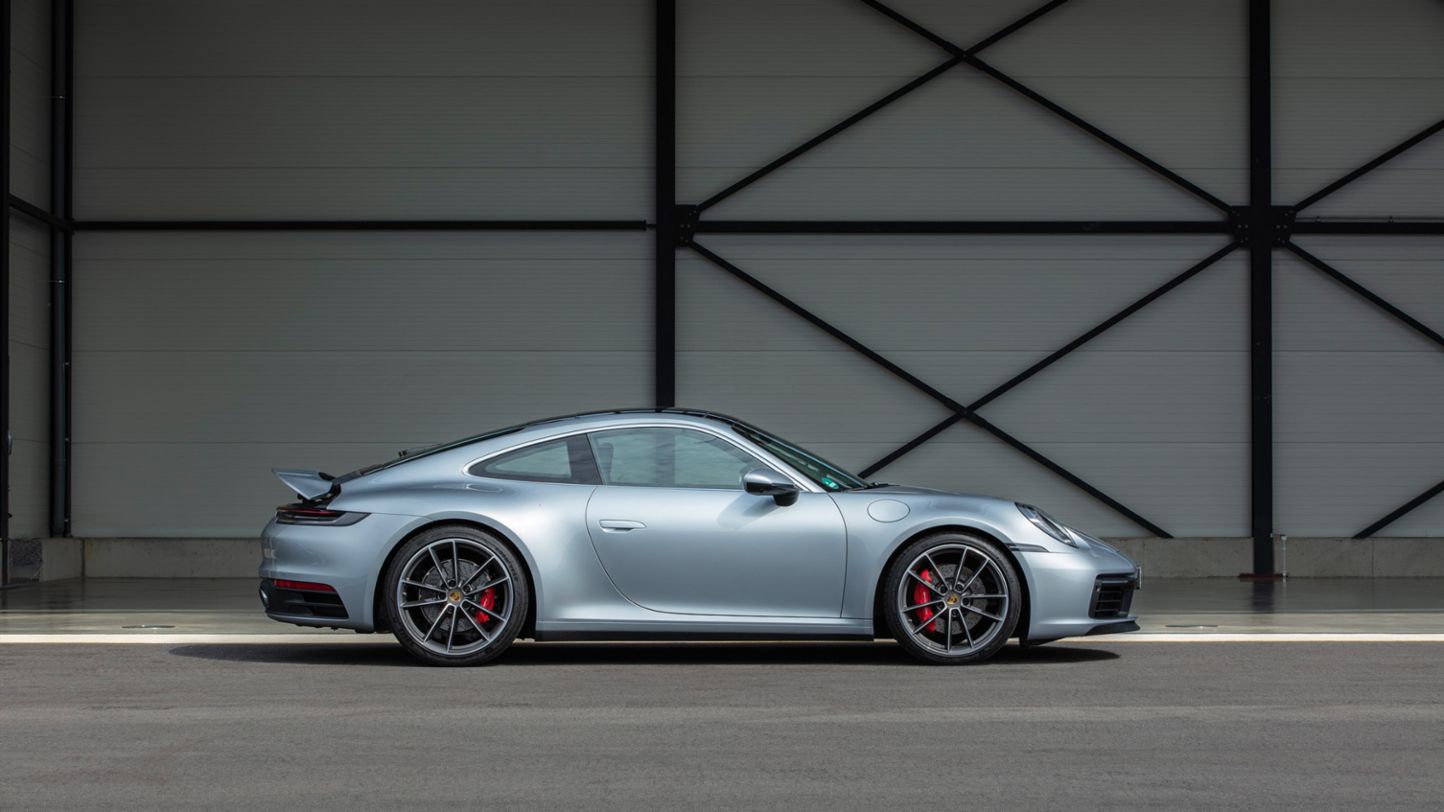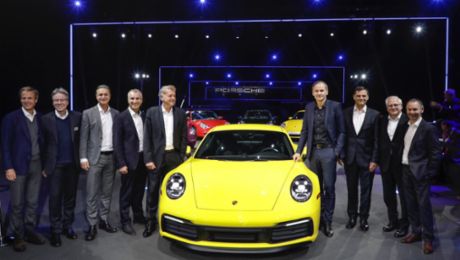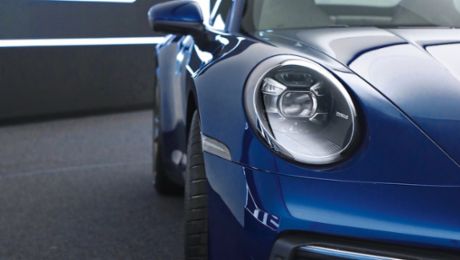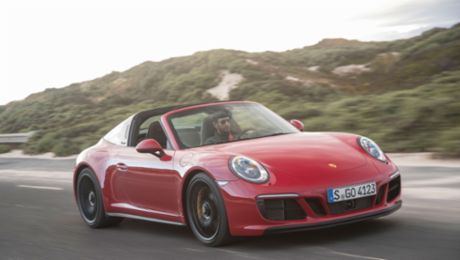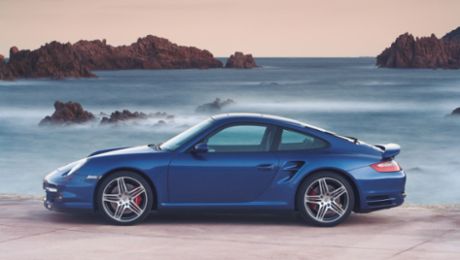Porsche 911 C Series /// G Model
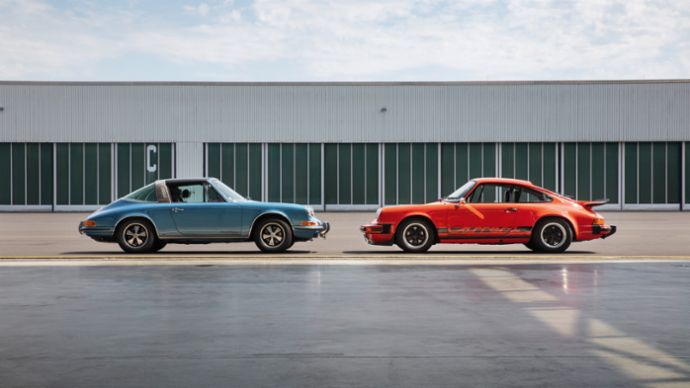
In 1963, the 911 made its debut as the 901 at the IAA in Frankfurt; sales started in 1964. The air-cooled boxer engine in the rear and the resulting omission of a classic radiator grille defined its layout and thus its DNA. One year later Porsche again presented the first Targa in Frankfurt. The original model was followed by the A, B, C, D, E and F Series. The wheelbase was extended in the B Series. The Targa shown here is a model of the C Series in beautiful Gemini Blue Metallic. The first major design change followed in 1973 with the G Series, now generally known as the G Model. A 1975 Carrera 2.7 delivering 210 PS with a large rear wing is part of the comparison of the eight 911 generations; this Porsche was painted in Continental Orange as was typical for the time.
Porsche 911 G model /// Type 964
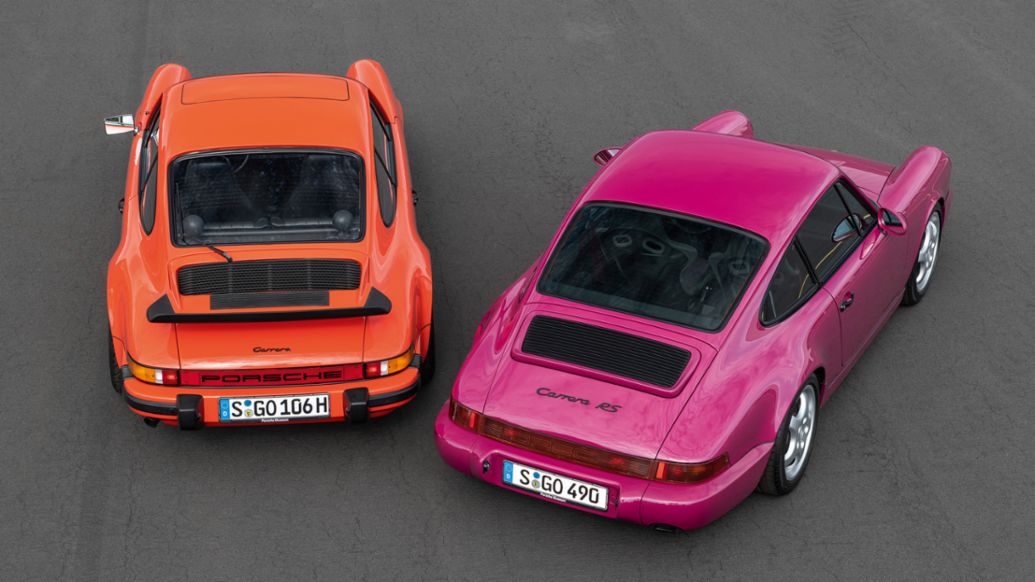
The bumpers with the black side bellows are the most striking design feature of the G model. They remained a feature of the 911 for an incredible 16 years. Only in 1989, with the premiere of the 964 Carrera 4 all-wheel drive, were the bumpers given a makeover and integrated into the body line as solid elements. The 964 in the comparison – a permanently rear-driven Carrera RS – was built in 1991. It had 260 PS with a weight of only 1,240 kilograms: a pure driving machine with automatically extending rear spoiler, painted in Ruby Star.
Porsche 911 Type 964 /// Type 993
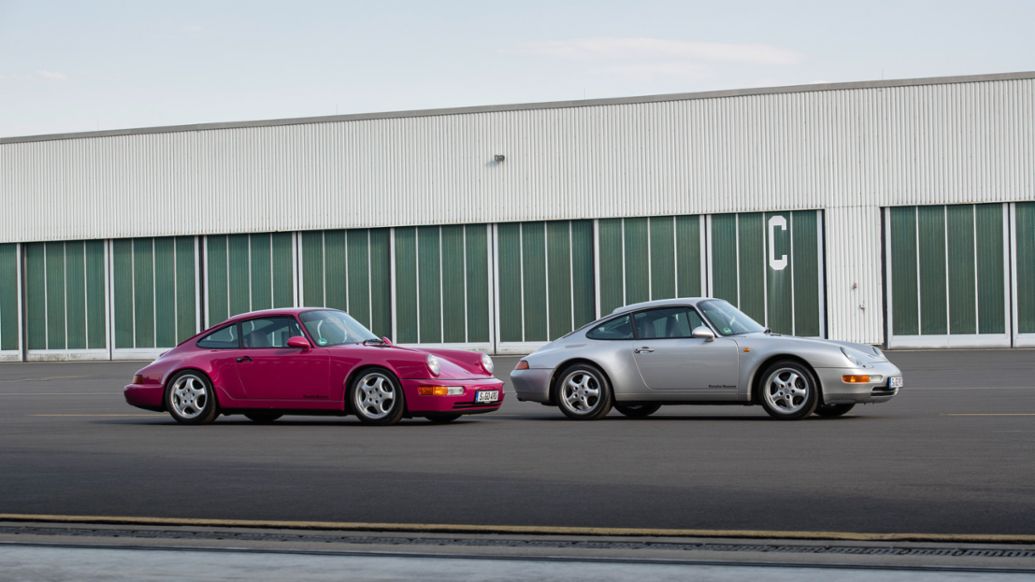
At first glance, only the inclined ellipsoid headlights of the 993 seem to distinguish it from the 964. Far from it. Most of the bodywork, including the front wings, luggage compartment lid, rear side panels, bonnet and bumpers were newly designed. With the 993, Harm Lagaaij succeeded in synchronising the design of the 911 with that of the 928 and the 968, thus creating a model family. Our 1997 993 C2 was built with 285 PS and painted in Arctic Silver Metallic.
Porsche 911 Type 996 /// Type 993
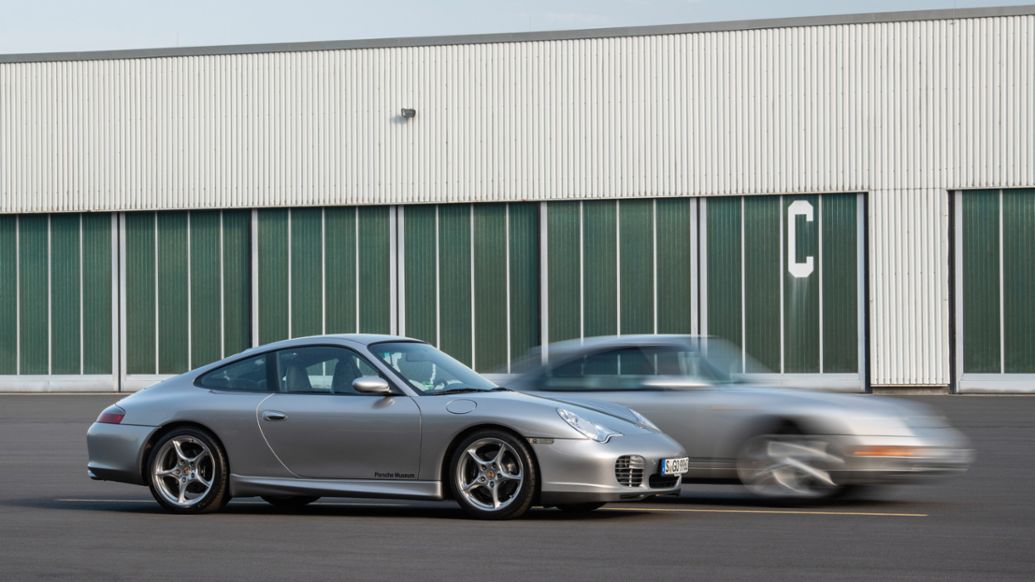
The 996 is the reflection of a paradigm shift. With it, in 1997 Porsche said goodbye to the air-cooled boxer engines and brought water cooling on board. The new design of this sports car had little in common with the 993 except for the engine layout. This departure from tradition was reflected in the design with provocative organic elements. The 911 Carrera shown here as the special model '40 years Porsche 911' was built in 2003 with 345 PS. Colour: GT Silver Metallic. Quantity produced: 1,963.
Porsche 911 Type 996 /// Type 997
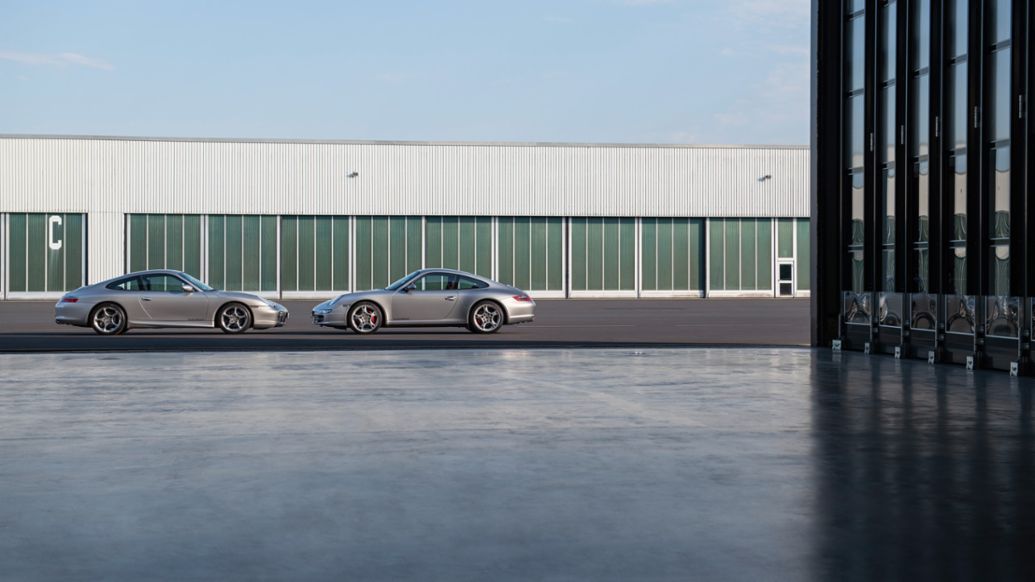
If you switch from the 996 to the 997, you think you're in a completely newly designed vehicle. But appearances are deceptive: the 997 introduced in 2005 is a type of super-facelift of the 996. A comparison of the silhouettes shown here – the 996 on the left and the 997 on the right – makes this very clear. With the 997, Porsche returned to the clean shapes of a 964 and a G Model. The 997 in this story is a 911 Carrera 4S with 355 PS, painted like the 996 in GT Silver Metallic. The design of both 911 models was created under the direction of Harm Lagaaij.
Porsche 911 Type 991 /// Type 997
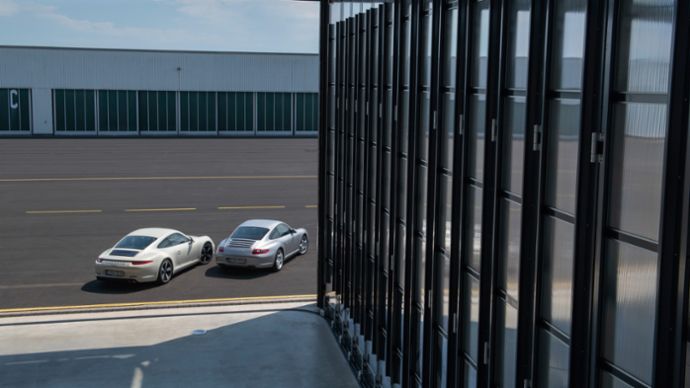
With the 991, Michael Mauer presented his first 911 in 2012. The leap from the 997 to the 991 is huge – visually as well as technically. While the 997 feels compact, the 991 looks much bigger. And it is too: the wheelbase increased by 100 millimetres. In addition, the axles moved further out. Nevertheless, the 991 was still extremely handy to drive. The Carrera S '50 Years 911' (2013) shown here delivers 400 PS and comes in Geyser Grey Metallic.
Porsche 911 Type 991 /// Type 992
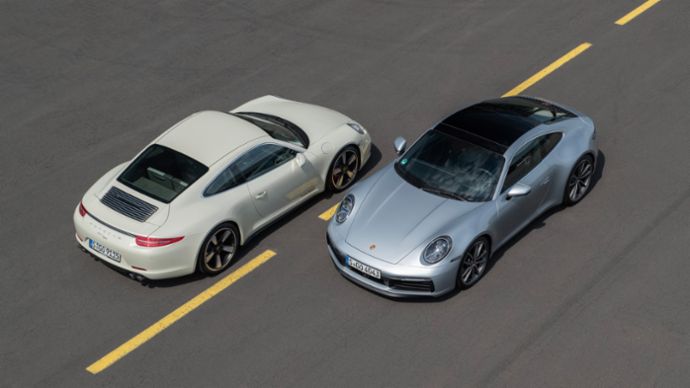
Michael Mauer's second 911 coup followed in 2019. And again he was true to his guiding principle of what a new 911 should look like: “I have to be able to see that it's a 911. And I have to be able to see that it's the new 911.” While the 991 is a more elegant sports car, the 992 is visually striking. With the wings and wheels now drawn further out of the body, the design team followed in the footsteps of the first 911 Turbo (the 930). The turbocharged 3.0-litre engine of the 911 Carrera 4S in this story developed 331 kW (450 PS; fuel consumption combined 9.0 l/100 km; CO2 emissions 206 g/km).
Eight generations of the Porsche 911, 56 years of sports car history, all in one location. The first 911 and the latest one are worlds apart. At the same time, they share a common DNA. Technically and aesthetically. But this DNA has changed, and been further developed from year to year. A comparison of all eight 911 generations should convey a feeling for how the 911 has changed in the last six decades, how the cars of the different eras feel, move, sound, smell and how they have changed, sometimes in just a few nuances and at other times in revolutionary ways. Mind you, this is not a comparative test and also not a complete chronological outline of the history of 911. It is about understanding each generation a little better and getting a clearer insight of their significance in the end. In order to look at the automotive icons even more clearly and across eras, we draw on the expertise of a man who has immersed himself in the DNA of the Porsche brand and the 911 like no other: Michael Mauer, born in 1962, Porsche chief designer and senior stylist of the Volkswagen Group.
“To see all eight generations of the 911 in one place is first of all a very uplifting feeling,” he says as he enters the melting pot of the eras – a hangar at the Siegerland airport near the Sauerland motorway, the A45. He adds: “Because it confirms what I always say: maybe the 911 is the only car that really has such a complete CV. I can think of two or three cars that also have an interesting story. But none have quite such a complete history.”
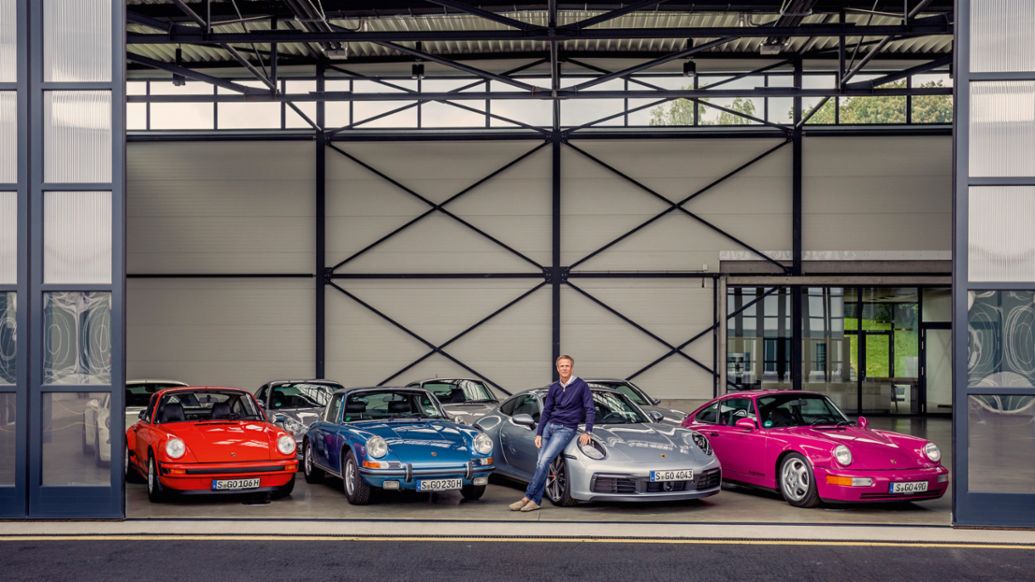
This history begins in 1963 with the world premiere of the Porsche 911 at the International Motor Show (IAA) in Frankfurt. At that time the successor of the 356 was still known as the 901. When it was launched on the market in 1964, this was still the case. But in the first year of production, Peugeot claimed the rights to the 0, and the new Porsche was called the 911 from then on. No problem. But far more importantly, even this first 911 – like the 356 – had a technical layout that still determines the shape of the series today: the boxer engine at the rear. Michael Mauer: “The layout is so characteristic. The shape of the car is closely related to this layout. If I had to fundamentally change the layout, it wouldn’t be a 911 any more."
So the boxer engine in the rear is the most important part of the 911 DNA. It's the one that links all the eight generations. With the exception of the current 992, a Porsche test car, they all come from the Porsche Museum collection. The first generation car is a 911 S Targa from the 1970 C Series; its 2.2-litre six-cylinder engine delivers 180 PS at the rear axle. This is followed by a 1975 911 Carrera 2.7 with 210 PS as the G Model and thus a second-generation 911. The third generation, the 964, is represented by a 1991 911 Carrera RS whose 3.6-litre engine is capable of 260 PS. The 993 marks the leap into the modern age from a visual point of view, delivering 285 PS from the 3.6-litre boxer engine as a 1997 Coupé and fourth generation model.
Number five is the 911 of a historical turning point: the 996, now equipped with a water-cooled instead of air-cooled boxer engine, it is the special model '40 Years of the 911' – built in 2003 again with a displacement of 3.6-litres and, in this exclusive case, 345 PS. Its successor, and therefore the sixth generation, was the 997, the 911 Carrera 4S with 355 PS from a displacement of 3.8-litres and with all-wheel drive, which was registered here in 2005. The 991, a car of the Mauer era and seventh generation, this beautiful 911 S was a special model '50 years of the 911'; the displacement of the boxer engine was 3.8 litres, the power output of the naturally aspirated engine 400 PS. From 2019, the eighth generation, the 992, has united the present and the future – here a 911 Carrera 4S with 331 kW (450 PS) from a turbocharged 3.0-litre engine.
C Series vs. G Model
It smells like a time before our time when you enter the C Series 911. The click of the clasp in the door opener, the springing open of the practically uninsulated doors, the seats with conventional headrests, the four-spoke steering wheel as a huge, albeit finely leathered rim. Everything fits perfectly. The rev counter is already in the middle, where it still works today. Of course, the ignition lock is on the left; a delicate key, turned to the right, wakes up the 2.2-litre six-cylinder engine, which at first is a little embarrassed and shakes, but then softly picks up speed like a turbine. Because this Targa is an S version, it has a five-speed transmission. The gear knob lies comfortably in the hand, only the gearshift pattern forces you to concentrate: from the centre position, the gear lever must be pushed down to the left to engage first gear. Even today, the car is still very easy and sporty to drive. In tight bends it presses down on the springs somewhat, but it still remains much more controllable on dry asphalt than one might think, given that it is now almost five decades old.
“The design of the 911 is characterised by a handful of features, starting at the front, a special topography where the wings are higher than the bonnet.” Michael Mauer
The leap to the G Model is like a father reminiscing about his youth, at least if one is a child of the 1960s. On the outside, it is mainly the bumpers with bellows adapted to more modern crash standards and the disappearance of chrome (with the exception of the exterior mirror) that distinguish the G from the C. Inside, the driver is catapulted forward through time by a much smaller steering wheel, seats with headrests that are now permanently integrated, a normal gearshift pattern for the optional five-speed transmission and a significantly more agile 2.7-litre engine. With its more direct, but still sluggish steering without power assistance and excellent brakes, the 911 Carrera 2.7 feels much more like a sports car than the C Series. If you had to travel further towards the present and climb into a 911 SC with 231 PS or the Carrera 3.0 with 217 PS with catalytic converter or even into a 930 Turbo, your feeling of making a leap from the Beatles era into that of Madonna would be complete. And yet the G Model cannot pulverise the charm of its predecessor in a direct comparison. Because even the grandiose Carrera 2.7 of this development stage looks like a very far-reaching update of the original 911 idea.
This is also due to the fact that the body, and thus the driver’s view of the wings, has not changed. Michael Mauer describes this feeling: “The design of the 911 is characterised by a handful of design features. It starts at the front – a special topography where the wings are higher than the bonnet. And that's because the engine is in the rear.” If you ignore the fact that the C Series shown here is a Targa, the parallels between the original model and the G Model can also be found in the side and rear sections. The chief designer adds:
“In the side elevation, it's the typical sloping roof and the resulting side window graphic.” At the rear, it is the two extensions of the rain channels that continue as incomparably elegant lines into the bonnet. Porsche calls it the flyline. If you stand behind the cars you will also notice how charismatically the cabin is drawn in and, further down, how the wings spread out parallel. Mauer: “These are design features that have changed and developed over the generations time and again, but whose basic characteristics can be found in all vehicles.”
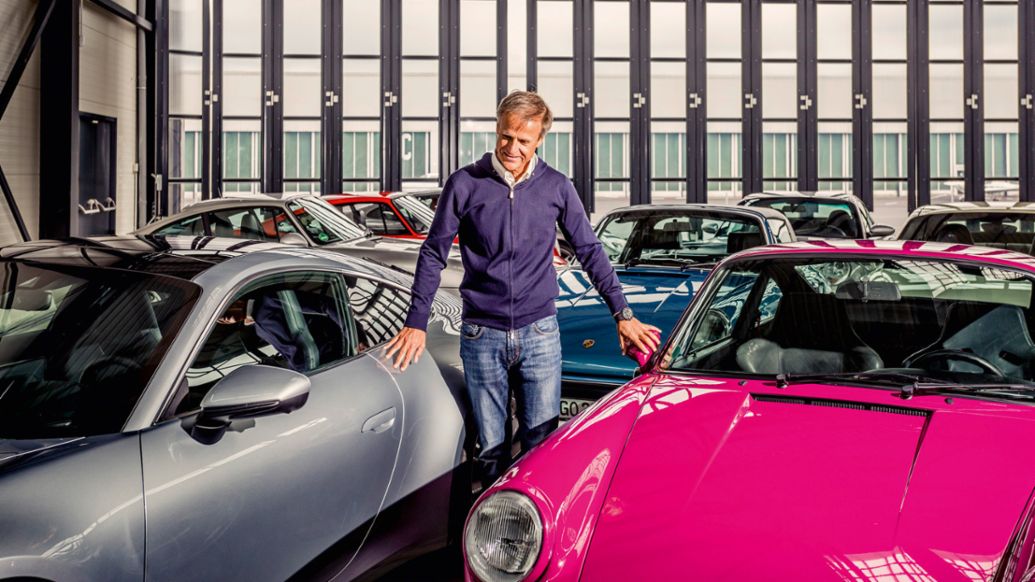
G Model vs 964
If you approach the 964 RS, you have to understand that the third generation of the 911 was introduced 26 years after the launch of the original model – first as the Carrera 4 with all-wheel drive. The car looks much more modern than the G Model with its homogeneous, bigger bumpers integrated into the body. Having said that, the doors and bonnet are almost identical and sound the same when opened and closed. Harm Lagaaij – who as a young designer at Porsche played an important part in the development of the 924, later went to other companies and then returned to Porsche in 1989 as chief designer – told us the following about this era some time ago: “After many years I returned and was given a 964 as a company car. I got in but I didn't get it: the car was completely new, and yet everything was the same...”
And that's exactly the same today when you get into a 964. At the end of the 1990s, this Porsche 911 – the third generation – lacked forward thinking in terms of its visual appearance. But this is a stroke of luck in 2019, because it transferred the shape and character of the first and second 911 into the 1990s with new technologies such as all-wheel drive, the completely new 3.6-litre engine, optional airbags and better crash protection, more ergonomic seats, power steering (not in the RS), a modern automatic transmission (Tiptronic), a completely newly designed chassis, improved aerodynamics (among other things due to a rear spoiler which automatically extends above 50 km/h) and a significantly better heating and air conditioning system. Today, the 964 provides a wonderful opportunity to drive a kind of high-tech, classic car. At that time, however, Porsche was faced with the problem of having three cars in its range, the 964, 928 and 944, which had hardly any identical parts and thus caused the company’s profits to gradually decrease further and further.
964 vs. 993
The leap from the 964 to the 993 is huge. If you don’t happen to own both cars so that you can frequently change between them, you soon lose sight of this fact. With the fourth generation, Harm Lagaaij was the new head of design and the technical development crew had taken over the difficult task of not only making the 911, but also the whole brand, fit for the future. The 993 was an intermediate step. The aim was to give the three model series, the 911, the 928 and the 944 (which then became the 968), a common visual identity. Harm Lagaaij: “Apart from the fact that there were no identical parts at all, they all looked extremely different. We knew that we had to move in a completely different direction. But in the years until all this would be implemented, my main task was to give the models a certain similarity.” By “different direction”, Lagaaij meant the reorientation of the brand – visually as well as technically. But before this took place and the 996 (and the Boxster as the 986) came into existence, the brand had to survive, and the most important model here was the 993. This is how the last and most modern of all the air-cooled 911s was created. It differed significantly from the 964 in terms of driving performance as it could easily be driven very fast. With the exception of the doors, practically every sheet metal part was new. The same applied to the wings and the new, angled headlights. Inside, the 993 still resembled the 964, but many components had a more high-quality feel.
In any case, Harm Lagaaij managed a balancing act that was later perfected more and more in the Porsche design: creating a successor carrying the DNA of the 911 and at the same time reinterpreting it. Michael Mauer, who succeeded Harm Lagaaij in 2004, says: “Creating a new 911 is a special challenge. The task is to develop the design of the 911 further while still always clearly visualising that it's a 911.”
993 vs. 996
With the water-cooled 996, Porsche not only reinvented the 911, but also the brand. With Wendelin Wiedeking as Chairman of the Executive Board, Horst Marchart as Head of Development and Harm Lagaaij as Head of Design, Porsche transformed itself from a smaller sports car manufacturer into the most profitable car manufacturer in the world, without giving up even a hint of its exclusivity. The 996 represented a technical and visual turning point. We will not go into the advantages and disadvantages of air and water cooling here. What is perfectly clear is that the era of modern sports cars starts with the 996.
“I think the 996 is a very significant model for Porsche in many respects, and in the history of the 911” Michael Mauer
An interesting fact: although the quality of the first 996 series was not able to compete with the innovative power of the new powertrains, things were quite different for the second series – recognisable from the outside by, among other things, the newly designed headlights compared to the Boxster. This applies in particular to the 911 Carrera '40 years of the 911' shown here, which was launched on the market in 2003 for the 40th anniversary of the 911 in a limited edition of 1,963 units with various exclusive details and a powerful 345 PS. You might have some criticism of the organic interior design and the headlights, but this Porsche 911 is superior to the 993 in every respect. A sports car with high travel comfort, an extremely responsive engine and an unusually high limit range. For drivers who also use the 996 in their everyday lives, the first ESP is also a life insurance policy that should not be underestimated. Too positive? No. As the last air-cooled 911, the 993 remains the icon of icons. But the progress is more noticeable between the fourth to the fifth generation than with any other 911 before. And the controversial look of the 996? “I think the 996 is a very significant model for Porsche in many respects, and in the history of the 911, as this change from an air-cooled to a water-cooled engine really represents a turning point,” says Michael Mauer. The designer continues: “I think you’ll see that the 996 – the older it gets – will find its fans and has already found them.” That’s how it is. Prices have not only bottomed out for exotic young classic cars like the Targa, the 4S, the '40 years of the 911', the Turbo, the GT2 and the GT3, but also for normal cars.
996 vs. 997
If you look at the 996 and the 997 from the side, you can already see from this visual perspective that generations five and six have a lot in common in terms of technology. Both basic models share the same wheelbase of 2,350 millimetres. With the 997, in 2005 Harm Lagaaij returned to a cleaner design. While the side sections are extremely similar except for the rear, the front and rear sections tend to the more classic 911 line. Round headlights replace the oval shape. And this is exactly what distinguishes the 997 from the 996: it transfers the extra space, comfort and speed into a cleaner exterior and interior design. In addition, the 997 provides even more safety, especially at high speeds. Our comparison strengthened the following assessment: the 996 was deliberately provocative, marked a new beginning and therefore offered its own charm. The 997, on the other hand, was the more precise, finer 996.
997 vs. 991 vs. 992
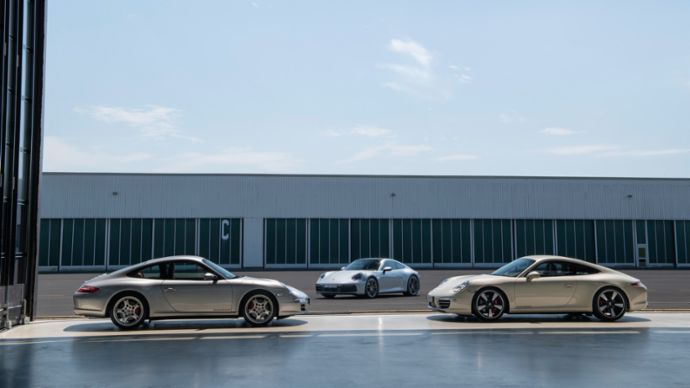
With the first 911 by chief designer Michael Mauer, he met his own requirement for the design of a new 911 generation. “I have to be able to see that it's a 911, and I have to be able to see that it's the new 911,” he says. Both are the case with the 991 presented in 2011 – an almost completely new car with 100 millimetres more wheelbase and shorter body overhangs. You sit pleasantly low and are reminded a little of the legendary Carrera GT and the 918 Spyder when you look at the centre console rising towards the front. Perhaps this is also a significant difference to the 997: in the 991 you feel like you're in a super sports car. This is even more true for the version of the special model '50 Years of 911', limited to 1,963 units and used by us for this timeline – a Carrera S with 400 PS, seat centre panels in the ‘Pepita’ houndstooth pattern and many other exclusive
details.
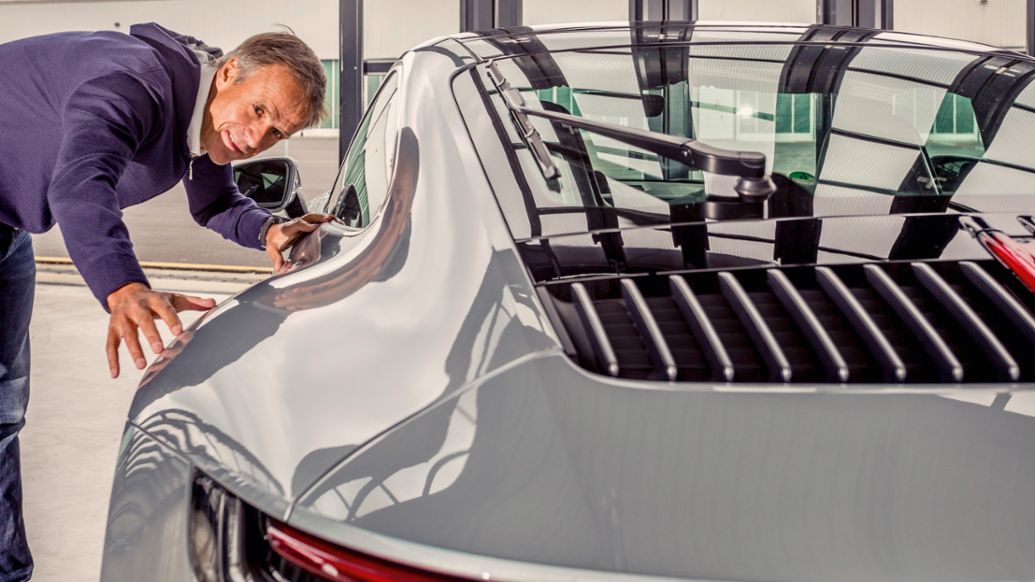
As a comparison between the 991 and the 997 clearly shows, the successor of every 911 may look more modern and technically break into a new dimension, but the predecessor remains desirable. No new 911 makes a replaced model look really old. Because the DNA is always continuous. And this is also the case with the new 992. It evokes the past, but also carries the idea of the 911 into the present. Michael Mauer: “This time we wanted the car to look more compact again.” He describes the style in which the wheels and tyres protrude slightly out of the body, like an athlete’s T-shirt that's just a little too tight. “Then we took a look at the history to see which car actually internalised that the best. And that was the 930 at the time - the first Turbo.” When Michael Mauer then says that the 930 was really a kindred spirit for the 992, he ennobles every other generation of the 911 as an automotive work of art for eternity – because they all have the same DNA.
Info
Text first published in the magazine „Porsche Klassik“, special edition „8 generations 911“
Author: Thomas Fuths
Photos: Markus Bolsinger, Heiko Simayer, Theodor Barth
Copyright: The image and sound published here is copyright by Dr. Ing. h.c. F. Porsche AG, Germany or other individuals. It is not to be reproduced wholly or in part without prior written permission of Dr. Ing. h.c. F. Porsche AG. Please contact newsroom@porsche.com for further information.
